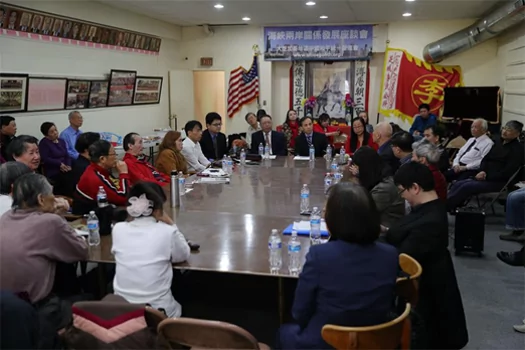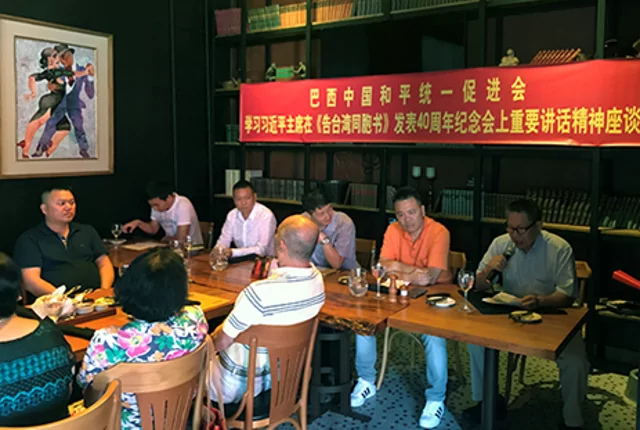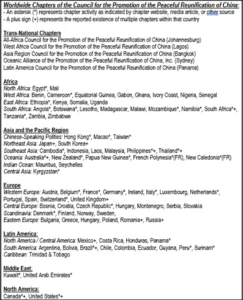
The United Front Work Department Goes Global: The Worldwide Expansion of the Council for the Promotion of the Peaceful Reunification of China
Publication: China Brief Volume: 19 Issue: 9
By:

Author’s note: This article follows from an article previously published in China Brief in February 2018: “The United Front Work Department in Action Abroad: A Profile of The Council for the Promotion of the Peaceful Reunification of China” (February 13, 2018). That article presented evidence that the Council for the Promotion of the Peaceful Reunification of China (CPPRC)—a nominal grassroots civic organization, with chapters in many countries worldwide—is in fact a front organization subordinate to the United Front Work Department of the Chinese Communist Party. [1] Building upon that earlier China Brief article, this article profiles the expansion of international chapters of the Council in countries throughout the world—to include its presence within the United States—and examines some of the ways that the CPPRC is used by the Chinese government as a vehicle for propaganda and influence efforts, and as a means to co-opt and control ethnic Chinese communities abroad.
Introduction
In January 2019, chapters of the Council for the Promotion of the Peaceful Reunification of China (Zhongguo Heping Tongyi Cujin Hui, 中国和平统一促进会), or CPPRC, were convened throughout the world to review a speech on Taiwan policy by Chinese Communist Party (CCP) General Secretary Xi Jinping (China Brief, February 15). Amid a push by People’s Republic of China (PRC) state media and officials to publicize the speech, representatives of CPPRC chapters from around the globe were lined up to issue fawning praise for Xi and his comments:
- From Africa, Feng Zhenyu, chairman of the CPPRC in Tanzania, stated that Xi’s policies are aligned with “national core interests…and will further promote the process of the peaceful reunification of the motherland.” Chen Jiannan, chairman of the CPPRC in Egypt, said that “overseas Chinese will firmly uphold the great cause of peaceful reunification of the motherland and make contributions to this end” (Xinhua, January 3).
- Zhu Liangwei, secretary-general of the U.K. Chinese Association for the Promotion of National Reunification, called Xi’s speech “informative, powerful and passionate, with far-reaching influence on the prospects of the peaceful development of cross-Strait relations” (Xinhua, January 3).
- At a January 25th banquet co-sponsored by the Thailand chapter of the CPPRC, chairman Wang Zhimin was among the speakers who stated that “Chairman Xi Jinping’s important speech profoundly made clear the development of cross-Strait relations and the historical trend of China’s eventual reunification, giving inspiration to overseas Chinese everywhere” (Thailand CPPRC, January 29).
- In the United States, the Chicago-area chapter of the CPPRC—“The Chinese American Alliance for China’s Peaceful Reunification”—was also featured in this media campaign: at a January 5th meeting, “Chairwoman Wang Yeqin, Honorary Chairman Li Hongwei, Chairwoman Zheng Zheng, Chairman Fang Yanhui and others discussed their reflections on President Xi’s speech, saying that it boosted the morale of all Chinese throughout the world and reinforced everyone’s confidence in the peaceful reunification of the nation” (Consulate-General of the PRC in Chicago, January 5).

Image: Liu Jun (head of the table, center), the PRC Consul General in Chicago, speaks at a January 5th, 2019 event organized by the “Chinese American Alliance for China’s Peaceful Reunification”—the Chicago-area chapter of the CPPRC. Liu praised Xi Jinping’s speech of January 3rd for stressing that “the future of Taiwan lies in national reunification and the welfare of our Taiwanese compatriots is intimately connected to national rejuvenation” (Consulate-General of the PRC in Chicago, January 5).

Image: Members of a chapter of the CPPRC in Brazil gather for a meeting on January 13th, 2019. The banner reads: “Symposium to Study the Spirit of the Important Speech of Chairman Xi Jinping Delivered on the 40th Anniversary of the ‘Letter to Taiwan Compatriots’” (Baxi Qiaowang, January 13).
The Global Expansion of the CPPRC
Revelations about CPPRC activities in Oceania over the past two years (China Brief, February 13, 2018; Wilson Center, September 2017)—and perhaps, recent revelations from Florida in the United States (see below)—indicate an organization that is becoming more active in covert political influence efforts on behalf of the Chinese government. Although the CPPRC is only one out a broad array of front organizations employed by the United Front Work Department (UFWD) and other PRC government agencies, it is the largest and most prominent—and arguably, the one that has come to exercise the greatest influence over ethnic Chinese communities abroad, as well as domestic politics in the countries where the CPPRC operates.
Furthermore, the examples of the January events cited above help to illustrate the extent to which chapters of the CPPRC have proliferated worldwide over the past two decades. Research for this article indicated the presence of CPPRC chapters in at least 91 countries or territories around the world; additionally, five transnational, regional chapters were also identified. These numbers cannot be considered conclusive: this list likely omits countries with active chapters that were not identified within the limited scope of this research effort; additionally, the list likely includes chapters that have a declared existence, but which may engage in little to no real-world activity. In order to arrive at a more definitive figure, further research would be required. [2] However, this list provides some sense of the global reach of the CPPRC, and the extent to which the UFWD now maintains a presence throughout the world. The list of 91 countries, divided by geographic region, is provided below.

CPPRC Chapters in the United States
The parent organization of the CCPRC has identified 36 chapters of the organization within the United States, located across ten states (California, Illinois, Iowa, Massachusetts, New Jersey, New York, Oregon, Pennsylvania, Texas, and Washington), as well as Washington D.C. and the territories of Puerto Rico and Guam. [3] The largest and most active chapters are located in urban areas with larger ethnic Chinese populations: two such examples are the “Chinese for Peaceful Reunification—Northern California” (CPR-NC, undated), and the “Greater Los Angeles Region Alliance for the Promotion of China’s Unification” (Consulate of the PRC in Los Angeles, April 12, 2016).
Until recently, a Florida-based chapter of the CPPRC was also in existence: this chapter garnered media attention in spring 2019, when it came to light that Cindy Yang, a Chinese-American fundraiser for Republican Party causes in Florida and a frequent visitor to President Trump’s Palm Beach property Mar-a-Lago, was a former vice-chair of the Florida CPPRC (Palm Beach Post, March 16, 2019). This chapter, the “Florida Association for China Unification Inc.,” has filed for dissolution as a legal entity (Florida Dept. of State, March 11, 2019); however, it remains to be seen whether this chapter will eventually reappear under a different name, and perhaps with different leadership.
The CPPRC as Tool for Organizing and Mobilizing Chinese Communities Overseas
Promotional media surrounding international chapters of the CPPRC has revealed a number of striking factors about the organization. For one, PRC government officials maintain a close supervisory relationship with individual chapters, and are prominently featured as speakers at CPPRC events. [4] Additionally, CPPRC-affiliated websites and other media are primarily in Chinese, rather than the language(s) of the host country; and photos of group meetings indicate a membership that is overwhelmingly composed of ethnic Chinese persons, with (at least thus far) little apparent effort to recruit beyond the scope of Chinese immigrant communities. These factors suggest that a key purpose behind the proliferation of chapters of the CPPRC is the intent of the Chinese government—with the United Front Work Department acting as one of its key executive agents—to exert control over ethnic Chinese communities abroad. This effort dates back to the aftermath of the Tiananmen Massacre in 1989, when CCP leaders found themselves alarmed by the strength of support for the pro-democracy movement among the Chinese diaspora—and began a long-term, determined effort to assert control over organizations and discourse in overseas Chinese communities. [5]
Suspicions regarding the potential dual loyalties (or suspected primary loyalty to Beijing) among ethnic Chinese communities have been a point of controversy in countries including the United States, and have prompted criticisms that such suspicions are unfounded and represent racial profiling (Committee of 100, April 7). However, it is unmistakable that Chinese government agencies are actively seeking to recruit agents of influence within ethnic Chinese communities, and to control discourse within these communities. The Chinese government seeks to create a propaganda feedback loop: using a variety of inducements, it creates synthetic civic organizations under its control to assert leadership of overseas Chinese communities, and then cites these organizations as evidence of a Chinese diaspora in lockstep support of the CCP. [6]
Conclusions
Front organizations such as the CPPRC represent one of the primary mechanisms employed by the CCP in its patient, long-term campaign to undermine the democratic norms and open debate—not only within China itself, but internationally—that the CCP views as threats to its own hold on power. In response, democratic societies targeted by the corrosive influence operations of authoritarian governments like the PRC must come to grips with this challenge, and take renewed efforts to defend themselves—through measures such as the reform of campaign finance laws, more stringent enforcement of foreign agents registration requirements, and exposure through independent media of front organizations and covert lobbying directed at political policymakers. However, in the end it may well be dissident voices within overseas Chinese communities who are most at risk of being intimidated into silence or drowned out by the megaphone wielded by rapidly expanding, state-controlled PRC front organizations such as the Council for the Promotion of the Peaceful Reunification of China.
The author is grateful to Howard Wang, the Jamestown China Program Assistant, for his research support in preparing this article; and to Alex Joske of the Australian Strategic Policy Institute for his constructive comments and additional information about the CPPRC in the southern Pacific.
John Dotson is the editor of China Brief. Contact him at: cbeditor@jamestown.org.
Notes
[1] In addition to the author’s previous article as cited, readers interested in the linkages between the Council and the Chinese government could consult a number of other references, to include: Anne-Marie Brady, “Magic Weapons: China’s Political Influence Activities Under Xi Jinping,” Wilson Center, Sep. 2017 (pp. 16-17), https://www.wilsoncenter.org/sites/default/files/for_website_magicweaponsanne-mariesbradyseptember2017.pdf; Mark Eades, “China’s ‘United Front’ Seeks to Undermine U.S. Support for Taiwan,” International Policy Digest, Sep. 11, 2017, https://intpolicydigest.org/2017/09/11/china-s-united-front-seeks-to-undermine-u-s-support-for-taiwan/; and Bethany Allen-Ebrahimian, “China Built an Army of Influence Agents in the U.S.,” The Daily Beast, July 18, 2018, https://www.thedailybeast.com/how-china-built-an-army-of-influence-agents-in-the-us?ref=scroll.
[2] A total of 76 country chapters were identified from the official Chinese-language homepage of the parent organization of the CPPRC (www.zhongguotongcuhui.org.cn). From this list, levels of chapter activity could not always be determined—meaning that some of the listed chapters might exist largely on paper, with minimal real-world activity. This source also indicated the existence of multiple chapters in some countries. (Of note, this central CPPRC website was apparently taken down in early March 2019, and remains down as of the publication of this article. The reasons for this are unknown. The data used in the preparation of this article was gathered prior to the website going dark.) In addition to the 76 national chapters identified on the CPPRC homepage, research for this article indicated 15 additional countries (or overseas territories) with CPPRC chapters (as indicated through either web presence or media references), for a total of 91. The author may answer specific questions about this list upon request.
[3] This list of U.S. chapters was obtained from the official Chinese-language homepage of the parent organization of the CPPRC (www.zhongguotongcuhui.org.cn). (See comments in endnote #2, above.)
[4] Many examples of this could be referenced. For two such examples, see: (1) PRC Consul (Douala, Cameroon) Zhang Daxing addressing the Cameroon chapter of the CPPRC during a November 2015 meeting: “Cameroon Council for the Promotion of the Peaceful Reunification of China Studies the Spirit of the ‘Xi-Ma Meeting'” [喀麦隆中国和平统一促进会学习“习马会”精神], Cameroon CPPRC, 2015-11-26, https://www.ccppr-cameroon.com/news/associationNews/65.html; and (2) PRC Consul Wu Baofeng’s connections to the New Caledonia chapter of the CPPRC, as mentioned in: “Consul Official Assigned to the Vanuatu Embassy Provides Consular Services to New Caledonia” [驻瓦努阿图使馆领事官员赴法属新喀里多尼亚提供领事服务], PRC Foreign Ministry, May 22, 2009, https://www.fmprc.gov.cn/web/gjhdq_676201/gj_676203/dyz_681240/1206_681890/1206x2_681910/t564002.shtml.
[5] U.S.-China Economic and Security Review Commission, 2009 Annual Report to Congress (U.S. Government Printing Office, Nov. 2009), pp. 163-165.
https://www.uscc.gov/sites/default/files/annual_reports/2009-Report-to-Congress.pdf.
[6] One noteworthy example of this was observable in March 2005, when PRC state media cited comments from CPPRC chapters around the world as evidence of overwhelming support from overseas Chinese communities for the PRC’s “Anti-Secession Law” directed at Taiwan. See: “Overseas Chinese Communities Back Anti-Secession Law,” Xinhua News Agency (in English), March 16, 2005. https://www.china.org.cn/english/features/ffl/123150.htm.




